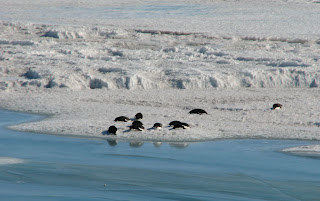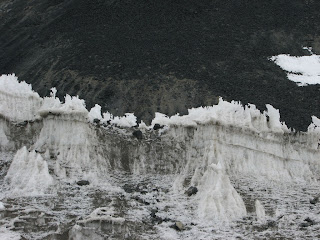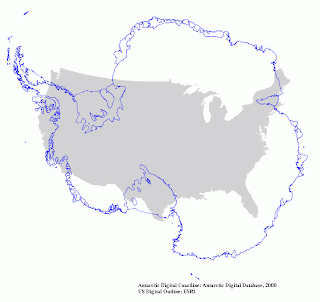Sunday afternoon. Another beautiful and unusually calm day in McMurdo, as I went on a walk after brunch on Hut Point Ridge with Alain Pautard. Alain is a mechanical engineer from Florida, working for Raytheon whom I’d met on my flight from Christchurch. We had set out on the trail with the intention of going far up on the ridge before turning back into town. We paused briefly at Hut Point when my eye caught sight of a few small, dark specks a couple of miles out on the sea ice. Could it be that they were penguins?? I hurriedly reached for my binoculars and confirmed that indeed this was my first sighting of penguins!!!
It was hard to identify what species they might have been from this distance, but from reading about penguins in this region I suspected them to be Adélies. We continued our hike up the ridge trying to occasionally check on the movement of the flock, but they seemed to have settled down on the ice. So, we wandered about for about an hour and as we turned back Alain pointed out that the birds were gone! Hmmm… well, we continued back towards Hut Point and just as we crossed the little bump of rock obstructing our view of the point we were surprised to see the Adélies sprawled on the ice about hundred feet off the shore!
 We scampered down the gravelly trail and sat down on the edge of the little cliff with a few other folks who had gathered to watch the penguin flock. All ten birds from the flock were enjoying the sunshine and were apparently taking an afternoon nap. We had missed seeing them walk which would’ve made a more live and exciting event. But, nonetheless it was exciting for me to see these birds for the first time and I got a few pictures too. Then one of the birds gave a little demonstration of Penguin-walk as it arose from its nap and walked to the edge of the ice, surveyed the water, and decided on a better spot to settle upon. With sea ice starting to thin and break up as the summer sun starts to warm Antarctica, we hope to see more of penguins and seals in the coming days.
We scampered down the gravelly trail and sat down on the edge of the little cliff with a few other folks who had gathered to watch the penguin flock. All ten birds from the flock were enjoying the sunshine and were apparently taking an afternoon nap. We had missed seeing them walk which would’ve made a more live and exciting event. But, nonetheless it was exciting for me to see these birds for the first time and I got a few pictures too. Then one of the birds gave a little demonstration of Penguin-walk as it arose from its nap and walked to the edge of the ice, surveyed the water, and decided on a better spot to settle upon. With sea ice starting to thin and break up as the summer sun starts to warm Antarctica, we hope to see more of penguins and seals in the coming days.
Adélie penguins gather on the ice off Hut Point for an afternoon nap.


After a delightful Christmas Eve dinner thanks to the amazing staff at the Galley, I headed for a little longer walk to Scott Base which is in the opposite direction from Hut Point. Yes, on a nice summer day in Antarctica you needn’t worry about it getting dark. It was a nice walk along the road to Scott Base and I was hoping to get a closer view of the ‘pressure ridges’ and have good light from the low evening sun for pictures .
.
The crowd at McMurdo is treated to a luxuriant dinner on Christmas Eve.The road to Scott Base passes between Ob Hill and the main ridge of the peninsula and its almost East-West alignment near McMurco make it susceptible for steady easterly winds. Along this stretch I noticed how the blowing winds had sculpted the ice on the slopes which was a fascinating sight for me. Soon, I took lead from another hiker ahead of me who left the main road and took a trail heading straight downhill for Scott Base. This was good, as it would save me walking on the long winding road ahead. As I approached the green buildings of Scott Base,
Mt. Erebus rose to the horizon above the ridge to my left.

Wind sculpted ice lined the slopes near Ob Hill.

The summit of Mt. Erebus seen from the trail to Scott Base
Compared to McMurdo, Scott Base looks like a small permanent camp-site and I was on the other side of the buildings before I knew it. Officially, I couldn’t enter any of the buildings and since my main objective on this walk was to get pictures of the pressure ridges, I stuck to it. The Pressure Ridges are essentially gigantic crumples or waves formed in the sea ice as it meets the edge of Ross Island and the Ross Ice Shelf. The crests of these crumples fail under the pressure creating dramatic and dangerous crevasses and cracks at the ice edge that rise above the surface to about 10 - 20 feet and extend for a couple of miles! Imagine pushing a carpet along the floor and placing a small obstruction at one of its leading corners. Only here the carpet is made of ice more than 50 meters thick!

Seals take advantage of these huge gaps and there can easily be a colony or two of seals surfacing from these cracks. I could constantly hear the calls of the seals nearby as I took pictures. Ofcourse, I didn’t step on the ice here because it is unsafe and hence prohibited by the rules of the USAP. There are some trails and a road that go around this treacherous zone and on my way back I observed a few skiers on one of the trails pass by another set of ridges on the sea ice a little South of the pressure ridges. Here, the sea ice has formed frozen wave-like features on the surface and are also starting to melt with the progressing summer.
The Pressure Ridges Gallery:
 Over the past few days, I’ve been learning about the geology of the area around McMurdo and I would like to share some of that knowledge with you.
Over the past few days, I’ve been learning about the geology of the area around McMurdo and I would like to share some of that knowledge with you. 



















































.jpg)